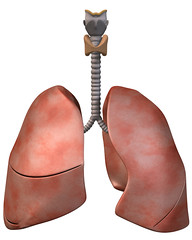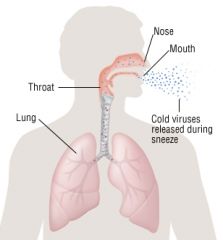![]()
![]()
![]()
Use LEFT and RIGHT arrow keys to navigate between flashcards;
Use UP and DOWN arrow keys to flip the card;
H to show hint;
A reads text to speech;
11 Cards in this Set
- Front
- Back
|
Respiratory (Acute)
|

Nose, Pharynx, Larynx, Trachea, Bronchi, Lungs
|
|
|
Acute Viral Rhinitis
|

Also called Coryza or Common Cold.
Viruses that invade the upper respiratory tract through airborne droplets cause it. |
|
|
Acute Bronchitis
|
Common condition that may follow a viral infection such as cold or influenza.
Usually viral in origin, but bacterial causes are also common. Irritation and inflammation may occur throughout the upper respiratory tract, resulting in an increased production of mucus. |
|
|
Influenza
|
A highly contagious acute viral respiratory infection also known as flu.
May be caused by several viruses usually known as A, B, C. Examples are Severe Acute Respiratory Syndrome (SARS), spring break of swine flu in 2009, and Avian flu or bird flu which affects birds but can be transmitted to humans that mutates and no vaccine is available for it. |
|
|
Pneumonia
|
Inflammation of certain parts of the lung such as the alveoli and bronchioles.
It may be caused by infectious (bacteria, fungi, nonspecific viruses) or noninfectious (irritatiing fume,s dust, or chemicals that are inhaled or foreign matter that is aspirated). It can be community acquired or hospital acquired |
|
|
Pleurisy (Pleuritis)
|
Inflammation of the visceral and parietal membranes that may be caused by pneumonia, TB, injury to chest wall, pulmonary infarction, and tumors.
The visceral and parietal membranes rub together during respiration and cause pain. Breathing and coughing aggravate the pain. Pleurisy usually occurs on one side of the chest. |
|
|
Chest Trauma
|
Traumatic injuries fall into two categories:
1.) Nonpenetrating injuries caused by automobile accidents, falls, blast injuries, rib fractures, pneumothorax, pulmonary contusion, and cardiac contusion. 2.) Penetrating injuries include pneumothorax and life threatening tears of the aorta, vena cava, or other major vessels. |
|
|
Pneumothorax
|
Often caused by chest injuries which is an accumulation of air in the pleural cavity that results in complete of partial collapse of a lung.
|
|
|
Hemothorax
|
Accumulation of blood between the chest wall and the lung that is often associated with pneumothorax.
It results from lacerated or torn blood vessels or lung tissues, lung malignancy or pulmonary embolus. It can also be a complication of anticoagulant therapy. |
|
|
Rib Fractures
|
The most common chest injury, which is the most common cause is blunt injury, especially the impact of steering wheel against the chest in an automobile accident.
Ribs 5 through 10 are most frequently fractured because they are least protected by chest muscles. It takes approx. 6 weeks for rib fractures to heal. |
|
|
Flail Chest
|
Refers to an injury in which two adjacent ribs on the same side of the chest are each broken into tow or more segments.
Paradoxical movement occurs when the pattern of movement is exactly the opposite of teh movement of an intact chest wall. Ventilation is impaired and the patient becomes hypoxemic. |

